Chess: Understanding the Ruy Lopez Opening (Marshall Gambit)
1 e4 e5 2 Nf3 Nc6 3 Bb5 a6 4 Ba4 Nf6 5 O-O Be7
6 Re1 b5 7 Bb3 O-O 8 c3 d5 9 exd5 Nxd5 10 Nxe5 Nxe5
11 Rxe5 c6 12 d4 Bd6 13 Re1 Qh4 14 g3 Qh3 15 Be3 Bg4
16 Qd3 Rae8 17 Nd2 Re6 18 a4 Qh5 19 axb5 axb5 20 Ne4
20 ... Bf5 21 Bd2 Rxe4 22 Rxe4 Nf6 23 f3 Qg6 24 Qf1 Nxe4
25 fxe4 Bxe4 26 Bf4 Bd3 27 Qf2 Bxf4 28 Qxf4 h6 Line
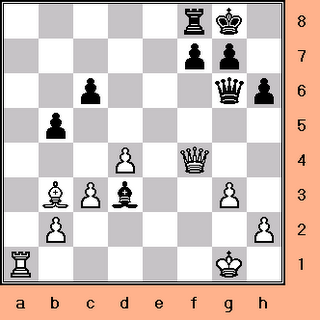
What's the game plan for Black?
* Sacrifice the e5 pawn in return for:
(i) an attack along the dark squares
(12 ... Bd6, 13 ... Qh4).
(ii) an attack along the light squares
(14 ... Qh3, 15 ... Bg4).
(iii) an open e-file (16 ... Rae8).
What's the game plan for White?
* Accept the proffered pawn (10 Nxe5).
* Prevent Black's dark- and light-squared
threats by 14 g3 and 16 Qd3 respectively.
* Promptly mobilize the queenside
(15 Be3, 17 Nd2).
* Liberate the a1 rook by opening up the
a-file (18 a4, 19 axb5).
1 e4
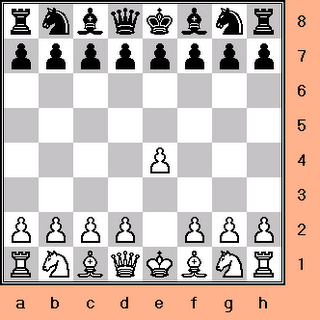
Opening up a diagonal for the Queen and f1 bishop, and,
attacking the d5 and f5 squares.
1 ... e5
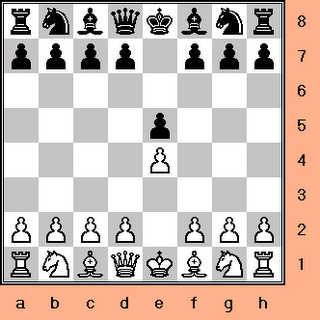
Black copies White with the same idea in mind.
2 Nf3
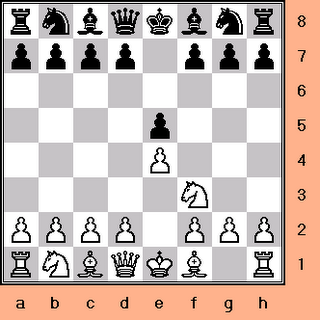
Not merely bringing the knight nearer the
center of operations but also assailing Black's
e5 pawn. If possible, always develop with attack
so as to speed up mobilization and harass the
enemy.
2 ... Nc6
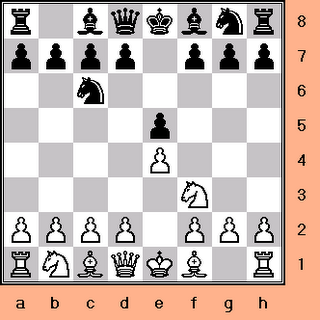
The knight comes out to protect the threatened pawn.
3 Bb5
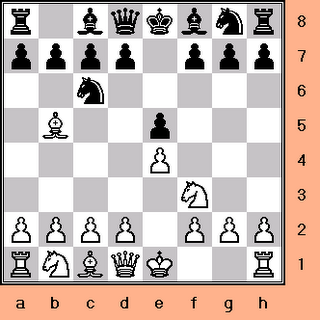
White indirectly attacks Black's e5 pawn by threatening
to remove its defender (Bxc6). Moreover, he prepares for
a rapid kingside castling and dissuades the advancement
of the d7 pawn because of the prospective pin on the
knight.
3 ... a6
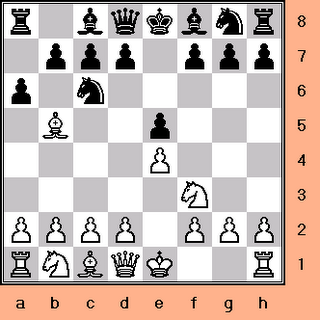
So that, when the bishop retreats to a4, he can hold in
reserve the possibility of driving it back altogether by
... b5.
3 ... Nf6
3 ... f5
3 ... g6
3 ... Bc5
3 ... Nd4
3 ... Nge7
3 ... d6
3 ... Bb4
3 ... Be7
3 ... a5
3 ... Qe7
3 ... Qf6
3 ... Nb8
3 ... Na5
3 ... Bd6
3 ... f6
3 ... Nce7
3 ... a6 (Closed Ruy Lopez)
3 ... a6 (Flohr-Zaitsev Variation)
3 ... a6 (Open Ruy Lopez Part I)
3 ... a6 (Open Ruy Lopez Part II)
3 ... d5? 4 Nxe5 Qg5 5 Nf3 Qe7 6 e5.
3 ... g5? 4 d4 Nxd4 5 Nxd4 exd4 6 Qxd4 Qf6
7 e5 Qe7 8 O-O c6.
4 Ba4
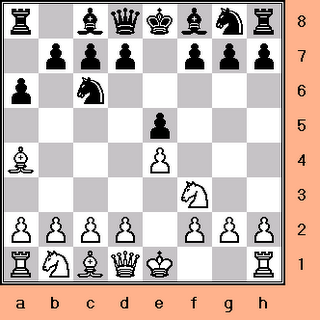
4 Bxc6
4 Bc4
4 Be2
4 Bd3
White cannot as yet win the e5 pawn by 4 Bxc6 dxc6
5 Nxe5 because of 5 ... Qd4, doubly attacking White's
e5 knight and e4 pawn. Consequently, White retires his
bishop to a4, and waits for a more propitious moment to
effect the exchange.
4 ... Nf6
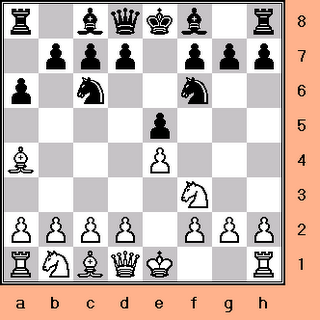
Developing the knight and counter-attacking White's
e4 pawn.
4 ... d6
4 ... b5
4 ... f5
4 ... Nge7
4 ... g6
4 ... Be7
4 ... Bc5
4 ... Qf6
4 ... Nd4
4 ... g5
4 ... f6
4 ... Bb4
5 0-0

White, however, can also ignore this attack.
5 Qe2
5 d4
5 d3
5 Nc3
5 Bxc6
5 c3
5 ... Be7
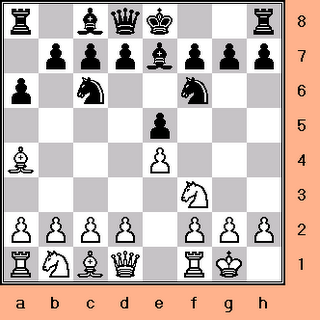
5 ... Nxe4
5 ... b5
5 ... Bc5
5 ... d6
5 ... Bd6
6 Re1
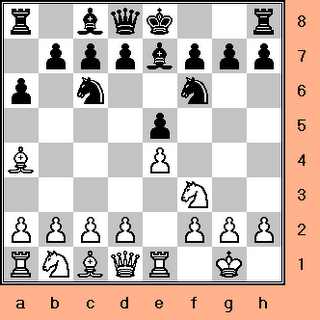
White now threatens to play 7 Bxc6 dxc6 8 Nxe5,
when 8 ... Qd4 will no longer work because of
9 Nf3.
6 Bxc6
6 Qe2
6 d3
6 d4
6 Nc3
6 c3
6 c4
6 ... b5
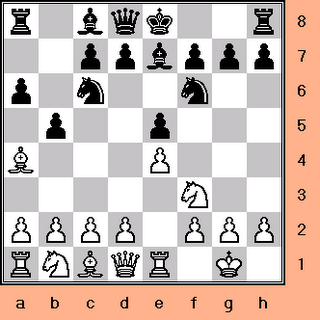
Eliminating the aforementioned threat.
6 ... d6
6 ... O-O
6 ... Bc5
7 Bb3
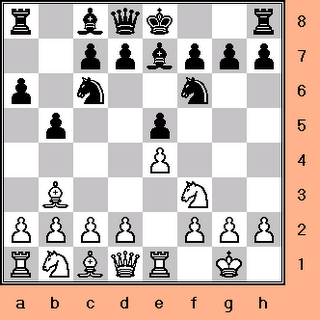
Moving out of harm's way.
7 ... O-O
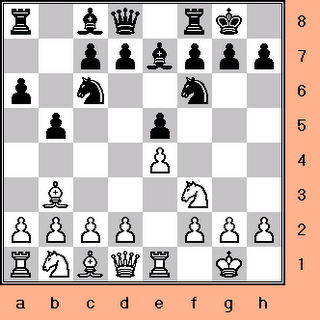
Securing the King and signalling Black's intent
to play the Marshall Gambit
8 c3
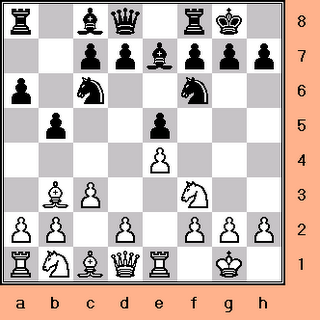
(i) Preparing to build up a pawn center by d4.
(ii) Giving the b3 bishop a retreat square on c2,
where it can check out Black's kingside along the
b1-h7 diagonal.
8 a3
8 Nc3
8 c4
8 Bd5
If White wants to avoid the jungle of complications associated with the text, he can adopt the Anti-Marshall approach via 8 a4. For instance:
8 a4 Bb7 9 d3 d6 10 Nc3 Na5 11 Ba2 b4 12 Ne2 c5
13 Ng3 Rb8 14 Nf5 Bc8 15 N3h4 Ne8 16 Nxe7+
16 ... Qxe7 17 Nf5 Qf6 18 Qg4 b3.
8 a4 b4 9 d3 d6 10 a5 Be6 11 Nbd2 Rb8 12 Nc4 Bg4
13 Be3 Nd7 14 h3 Bxf3 15 Qxf3 Bg5 16 Ba4
16 ... Bxe3 17 Qxe3 Nd4 18 c3 bxc3.
8 ... Rb8 9 axb5 axb5 10 d4 d6 11 d5 Nb4 12 Qe2 Na6
13 Nbd2 Qd7 14 c4 Nc5.
8 a4 d5 9 axb5 dxe4 10 bxc6 exf3 11 Qxf3 e4 12 Qe2 Qd6
13 Nc3 Bf5 14 Ra5 Bg6 15 Nd5 Bd8.
8 d4 is another option for steering the game away from gambit play:
8 d4 d6 9 c3 Bg4 10 d5 Na5 11 Bc2 c6 12 h3 Bc8
13 dxc6 Qc7 14 Nbd2 Qxc6 15 Nf1 Nc4 16 Ng3
16 ... Re8 17 a4 Bb7 18 Bd3 Bf8 19 Qe2 d5
20 axb5 axb5 21 Rxa8 Bxa8 22 exd5 Nxd5
23 Nf5 e4 24 N3d4.
8 d4 Nxd4 9 Nxd4 exd4 10 e5 Ne8 11 Qxd4 c5 12 Qe4 Rb8
13 c4 Bb714 Qf5 d6 15 Nc3 dxe5 16 cxb5 axb5
17 Bc2 g6 18 Qxe5.
8 d4 Nxd4 9 Nxd4 exd4 10 e5 Ne8 11 Qxd4 Bb7 12 c4 bxc4
13 Qxc4 d5 14 exd6 Nxd6 15 Qg4 Bf6 16 Nc3 Rb8
17 Bf4 Bc6 18 Rad1 Rb4.
8 d4 Nxd4 9 Nxd4 exd4 10 e5 Ne8 11 Qxd4 Bb7 12 Bd5 c5
13 Qe4 Bxd5 14 Qxd5 Nc7 15 Qf3 d5.
8 d4 exd4 9 e5 Ne8 10 Bd5 Bb7 11 Nxd4 Rb8 12 Nf5 Kh8
13 Nc3 f6 14 e6 dxe6 15 Rxe6.
8 d4 exd4 9 e5 Ne8 10 Bd5 Rb8 11 Be4 f6 12 Qd3 fxe5
13 Bxh7+ Kh8 14 Nxe5 Nxe5 15 Rxe5 d6 16 Re2 c5
17 Bg6 Bh4.
8 d4 exd4 9 e5 Ne8 10 Nxd4 Nxd4 11 Qxd4 c5 12 Qe4 Nc7
13 c4 bxc4 14 Bc2 g6 15 Bh6 Re8 16 Nc3 (16 Qxc4) 16 ... Rb8
17 Qxc4 Rb4 18 Qd3 Rh4.
8 d4 exd4 9 e5 Ne8 10 Nxd4 Nxd4 11 Qxd4 c5 12 Qe4 Rb8
13 c4 Bb7 14 Qe2 b4 15 Nd2 Nc7 16 Ne4 Ne6 17 Qd3.
8 d4 exd4 9 e5 Ne8 10 Nxd4 Nxd4 11 Qxd4 Bb7 12 c4 bxc4
13 Qxc4 d5 14 exd6 Nxd6 15 Qg4 Bf6 16 Nc3.
8 d4 exd4 9 e5 Ne8 10 Nxd4 Nxd4 11 Qxd4 Bb7 12 Qg4 c5
13 c3 d5 14 Nd2 Qb6 15 Bc2 Bc8 16 Qe2 g6 17 a4 bxa4
18 Bxa4 Ng7.
8 h3 Bb7 9 d3 d6 10 a3 Na5 11 Ba2 c5 12 Nc3 Nc6
13 Nd5 Nxd5 14 Bxd5 Qc7 15 c3 Nb8 16 Bxb7 Qxb7 17 d4 Nd7.
8 d3 d6 9 c3 Na5 10 Bc2 c5 11 Nbd2 Re8 12 Nf1 Nc6
13 h3 h6 14 Ng3 Bf8 15 d4 cxd4 16 cxd4 exd4 17 Nxd4 Nxd4
18 Qxd4 Be6 19 Bf4 Rc8 20 Bb3 d5.
8 ... d5
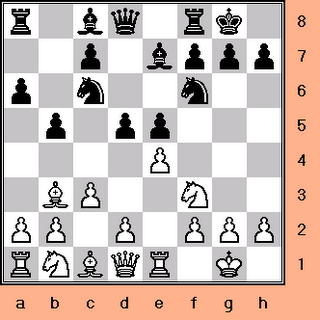
Initiating the Marshall Gambit. Black threatens
to capture on e4 (... dxe4) in order to attack the
f3 knight and stifle White's game in the center.
8 ... d6
8 ... Bb7
8 ... Re8
9 exd5
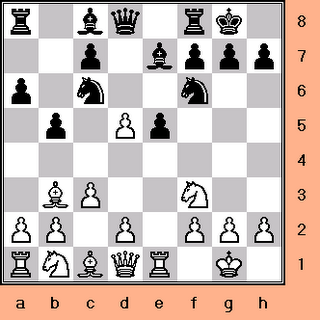
Preventing 9 ... dxe4 and threatening to capture the
knight.
9 d4 exd4.
9 d4 Nxe4.
9 d4 dxe4.
9 d3 dxe4 10 dxe4 Qxd1 11 Bxd1 Bb7/ 11 ... Rd8/ 11 ... Bg4.
9 a4 dxe4 10 axb5 exf3 11 bxc6 fxg2 12 d4.
9 a4 Bb7 10 axb5 axb5 11 Rxa8 Bxa8 12 d4 Nxe4 13 dxe5 Bc5
14 Re2 Ne7.
9 ... Nxd5
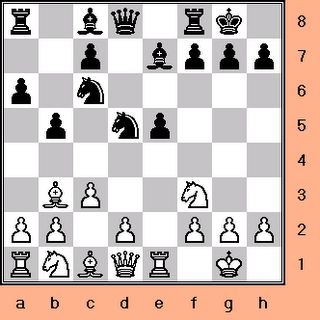
Gaining his pawn back.
9 ... e4 10 dxc6 exf3 11 d4 fxg2 12 Bg5/12 Qf3.
9 ... e4 10 dxc6 exf3 11 d4 Re8/ 11 ... Bg4/ 11 ... Bd6.
9 ... e4 10 dxc6 exf3 11 Qxf3 Bg4 12 Qg3 Re8 13 Re3/ 13 f3/
13 Re5.
10 Nxe5
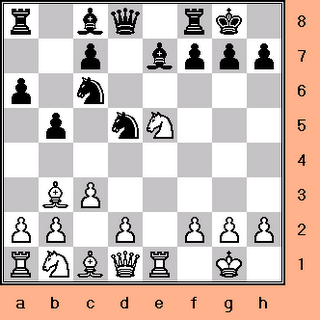
10 a4
10 d3
10 h3
10 d4 exd4 11 cxd4 Bg4 12 Nc3 Nb6.
10 ... Nxe5
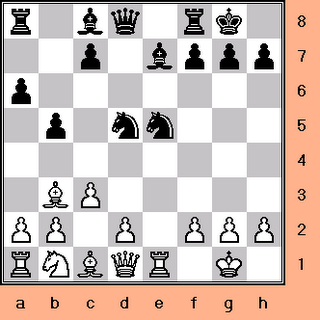
11 Rxe5
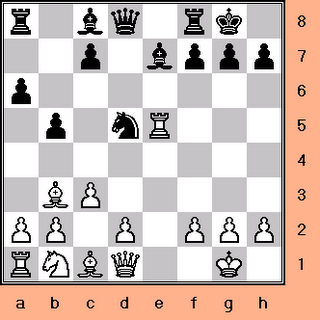
White wins the e5 pawn and attacks the d5 knight a
second time.
11 ... c6
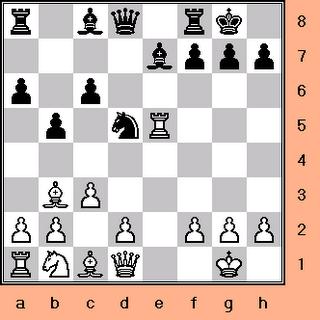
Since the knight is attacked twice and protected only
once, Black shields it a second time.
11 ... Bd6 12 Re1 c6 13 d4/ 13 d3/ 13 g3/ 13 a4.
11 ... Bd6 12 Rxd5 Re8 13 g3 Bb7 14 d4 Qd7.
11 ... Bb7 12 d4 Bf6 13 Re1 Re8 14 Na3 b4 15 Nc4 bxc3 16 Na5.
11 ... Nf6 12 d4 Bd6 13 Re1 Ng4 14 h3 Qh4 15 Qf3 Nxf2 16 Bd2.
11 ... Nb6 12 d4 Bd6 13 Bg5 Qd7 14 Re1 Bb7 15 Nd2 Rae8
16 Bh4 Rxe1+ 17 Qxe1 Re8 18 Qd1.
11 ... Nf4 12 d4 Ng6 13 Re1 Bb7 14 Nd2 c5 15 Nf3 c4 16 Bc2 f5
17 Ne5 Qd5 18 f3 Nxe5 19 dxe5 Qe6.
12 d4
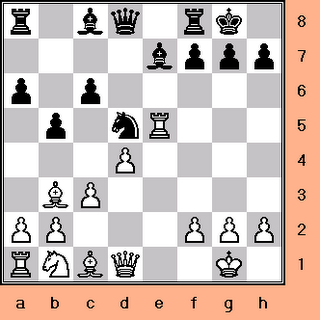
(i) Supports e5.
(ii) Contends for c5.
(iii) Enables queenside development.
The c1 bishop is about to jump into the game along
the c1-h6 diagonal, and, thereafter, the b1 knight
can join the action by maneuvering towards the center
(Nb1-d2-e4/f3).
However, White has to put all those ambitions on hold,
because from now on he's forced to play to Black's tune.
That's the price of winning the e5 pawn (10 Nxe5/ 11 Rxe5)!
12 d3
12 Bxd5
12 Re1
12 g3
12 Qf1
12 h3
12 Bc2
12 ... Bd6
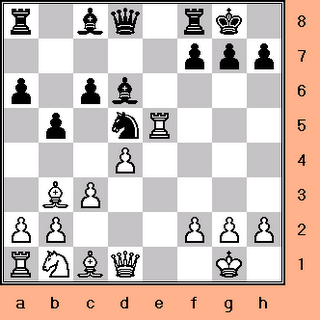
And the onslaught begins with an attack on White's
forward rook.
13 Re1
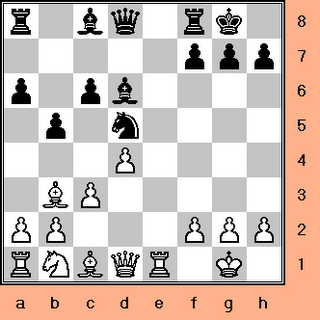
Back to square one.
13 Bg5 Qc7.
13 Re2 Qh4 14 g3 Qh5 15 Nd2 Bh3 16 f3.
13 ... Qh4
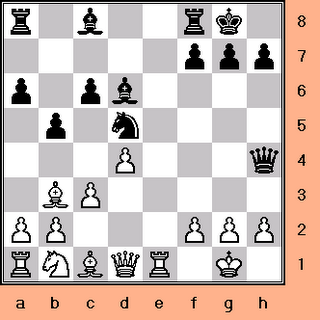
The queen works in conjunction with the d6 bishop
to pressurize White's h2 pawn (14 ... Qxh2+/ 14 ... Bxh2+).
14 g3
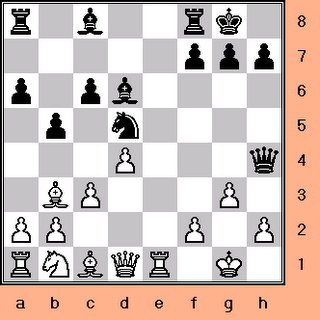
Eliminating the threat of 14 ... Qxh2+/ 14 ... Bxh2+.
14 h3 Bxh3 15 gxh3 Qxh3 16 Re5 Bxe5 17 dxe5 Rfe8.
14 h3 Bxh3 15 gxh3 Qxh3 16 f4 Nxf4 17 Bxf4 Bxf4.
14 h3 Bxh3 15 Bxd5 cxd5 16 gxh3 Qxh3 17 f4 Rae8.
14 h3 Bxh3 15 Bxd5 cxd5 16 gxh3 Qxh3 17 Be3 Bh2+
18 Kh1 Rfe8.
14 ... Qh3
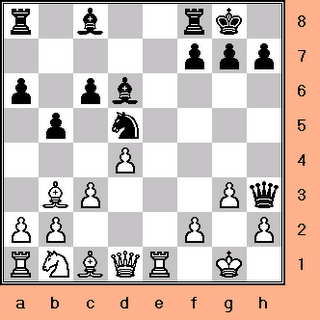
Since 14 g3 foils his dark-squared invasion
(14 ... Qxh2+/ 14 ... Bxh2+), Black turns his attention
to attacking the light squares. The queen and c8 bishop
team up in preparation for an assault on White's kingside.
15 Be3
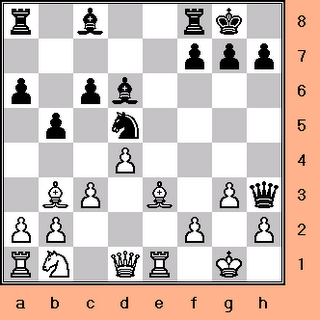
Urgently developing his queenside.
15 Bxd5
15 Qd3
15 Qf3
15 a4
15 Bc2
15 Re4 g5 16 Qe2 f5 17 Bxd5+ cxd5 18 Re6 f4 19 Rxd6 Bg4
20 Qf1 Qxf1+ 21 Kxf1 Rae8 22 Bd2 Bh3+ 23 Kg1 fxg3 24 hxg3 Re2 25 Be3 Rxe3 26 fxe3 Rf1+ 27 Kh2 g4 28 Rxd5 Rf2+.
15 Re4 g5 16 Qe2 f5 17 Bxd5+ cxd5 18 Re6 f4 19 Rxd6 Bg4
20 Qf1 Qxf1+ 21 Kxf1 Rae8 22 Bd2 Bh3+ 23 Kg1 fxg3 24 hxg3 Re2 25 Be3 Rxe3 26 fxe3 Rf1+ 27 Kh2 g4 28 Nd2 Rxa1 29 Rxa6 Re1.
15 Re4 g5 16 Qe2 f5 17 Bxd5+ cxd5 18 Re6 f4 19 Rxd6 Bg4
20 Qf1 Qxf1+ 21 Kxf1 Rae8 22 Bd2 Bh3+ 23 Kg1 fxg3 24 hxg3 Re2 25 Rh6/ 25 f4.
15 Re4 g5 16 Qe2 f5 17 Bxd5+ cxd5 18 Re6 f4 19 Rxd6 Bg4
20 Qf1 Qxf1+ 21 Kxf1 Rae8 22 Bd2 Bh3+ 23 Re2/ 23 f3.
15 Re4 g5 16 Qe2 f5 17 Bxd5+ cxd5 18 Re6 f4 19 Rxd6 Bg4
20 Qf1 Qxf1+ 21 Kxf1 Rae8 22 Bd2 fxg3 23 hxg3 Bh3+.
15 Re4 g5 16 Qe2 f5 17 Bxd5+ cxd5 18 Re6 f4 19 Rxd6 Bg4
20 Qf1 Qxf1+ 21 Kxf1 Rae8 22 Bd2 Re2.
15 Re4 g5 16 Qe2 f5 17 Bxd5+ cxd5 18 Re6 f4 19 Rxd6 Bg4
20 Qf1 Qxf1+ 21 Kxf1 Rae8 22 Rh6 Rf6.
15 Re4 g5 16 Qe2 f5 17 Bxd5+ cxd5 18 Re6 f4 19 Rxd6 Bg4
20 Rh6/ 20 Qe5/ 20 Qd3/ 20 f3.
15 Re4 g5 16 Qe2 f5 17 Bxd5+ cxd5 18 Re6 Bxe6?.
15 Re4 g5 16 Qe2 f5 17 Re6/ 17 Re8.
15 Re4 g5 16 Qe2 Nf6/ 16 ... Bf5.
15 Re4 g5 16 Qf3 Bf5 17 Bxd5 cxd5 18 Re3 Rad8 19 Nd2 Rfe8
20 a4/ 20 b3/ 20 a3.
15 Re4 g5 16 Qf3 Bf5 17 Bxd5 cxd5 18 Re3 Be4 19 Rxe4 dxe4
20 Qf6 Qg4 21 Nd2 Rae8 22 Nf1 Be7 23 Qxa6 f5 24 Qxb5.
15 Re4 g5 16 Qf3 Bf5 17 Bxd5 cxd5 18 Re3 Be4 19 Rxe4 dxe4
20 Qf6 Qg4 21 Qxg5+ Qxg5 22 Bxg5 f5.
15 Re4 g5 16 Qf3 Bf5 17 Bc2 Bxe4 18 Bxe4 Qe6 19 Bxg5 f5
20 Bd3/ 20 Bxd5.
15 Re4 g5 16 Qf3 Bf5 17 Bc2 Bf4/ 17 ... Rae8/ 17 ... Nf4.
15 Re4 g5 16 Qf3 Bf5 17 Nd2/ 17 Re1.
15 Re4 g5 16 Qf1/ 16 Bxg5/ 16 Nd2.
15 Re4 Qd7/ 15 Bb7/ 15 Bd7/ 15 Nf6.
15 ... Bg4
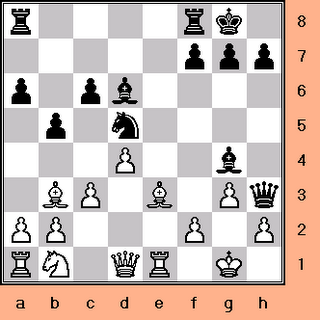
Not only attacking the queen but also setting up for
... Bf3 and ... Qg2 mate.
15 ... Re8
15 ... Be6
15 ... Bf5
15 ... Ra7
16 Qd3
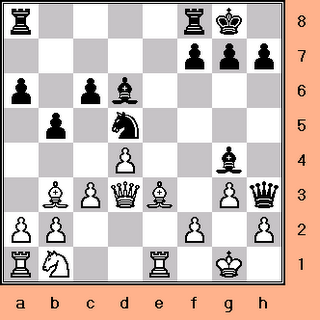
Evading capture and enabling Qd3-f1. Should Black
threaten ... Bf3 and ... Qg2 mate, White can cover
g2 by way of Qd3-f1.
16 f3? Bxg3.
16 ... Rae8
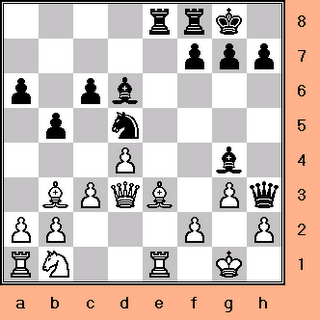
The idea is to pressurize the e-file, particularly e3.
16 ... f5
16 ... Nxe3
16 ... Nf4
16 ... Bf3
16 ... Kh8
16 ... Rfe8
17 Nd2
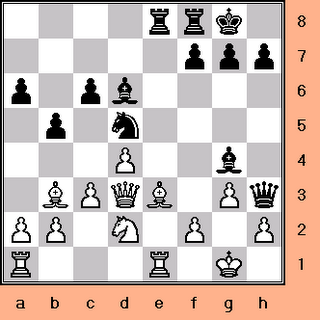
Mobilization towards e4/f3.
17 Bd1.
17 Bxd5 cxd5 18 Qf1 Qh5 19 Nd2 f5 20 f4.
17 ... Re6
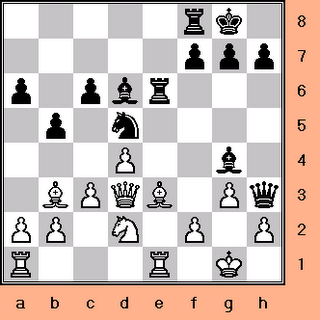
(i) Facilitates the doubling of rooks on the e-file.
(ii) Positions the rook for a potential kingside relocation
(Re6-h6).
17 ... f5
17 ... Qh5
17 ... Kh8
18 a4
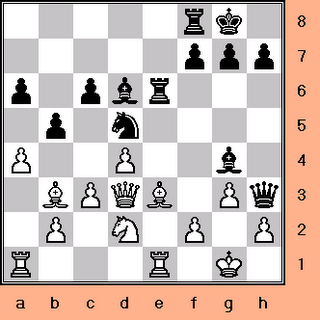
18 c4
18 Qf1
18 Bd1
18 Bxd5
18 ... Qh5
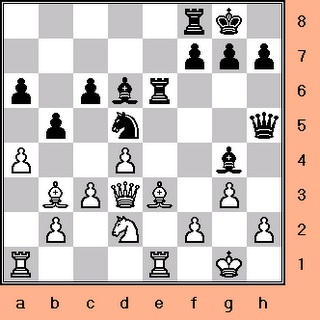
18 ... f5
18 ... bxa4
18 ... b4
18 ... Rfe8
18 ... Bxg3
18 ... Nxe3
18 ... Bf4
19 axb5
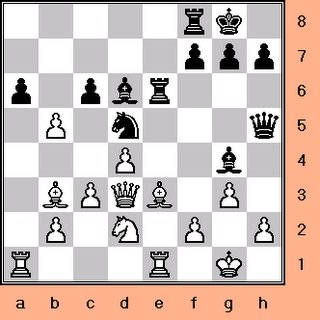
19 Qf1
19 Nf1
19 Bd1
19 ... axb5
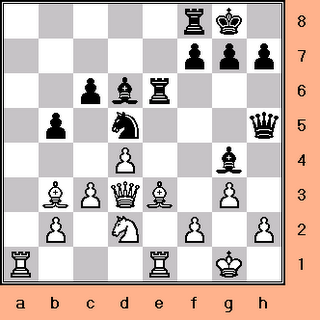
20 Ne4
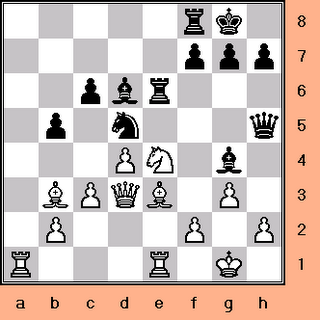
20 Nf1
20 Qf1
20 c4
20 Bd1
20 Bxd5
20 ... Bf5
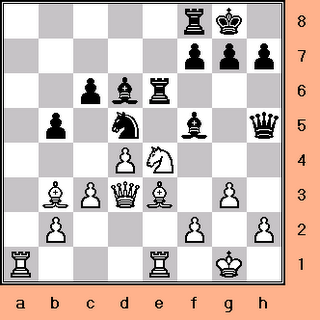
20 ... Bc7
21 Bd2

21 Bd1
21 ... Rxe4
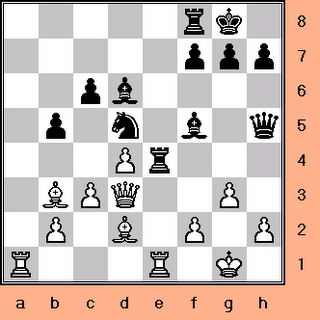
21 ... Rfe8
22 Rxe4
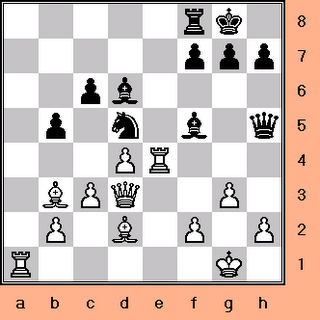
22 ... Nf6
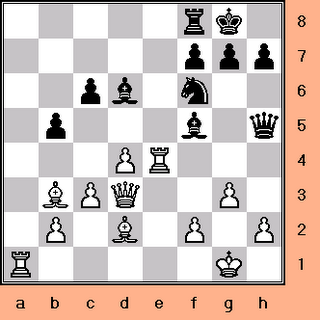
22 ... Qg6
23 f3
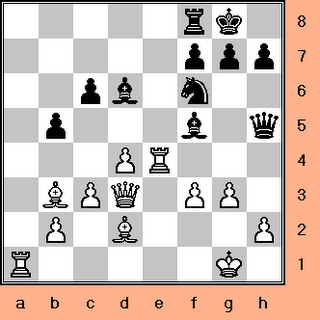
23 ... Qg6
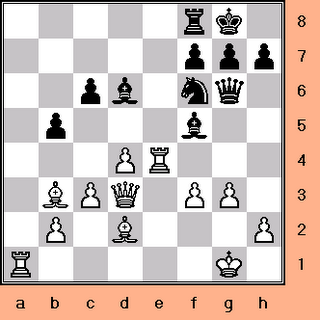
24 Qf1
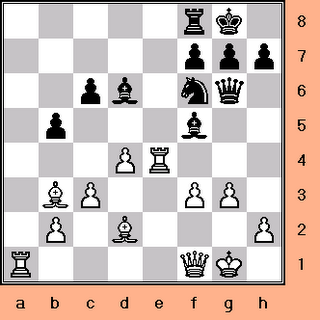
24 Bc2
24 Qe2
24 Qe3
24 Rae1
24 ... Nxe4
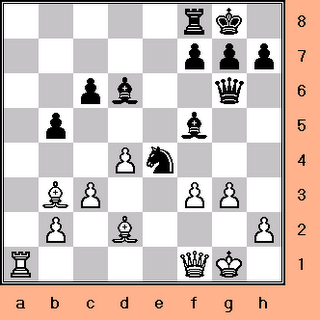
25 fxe4
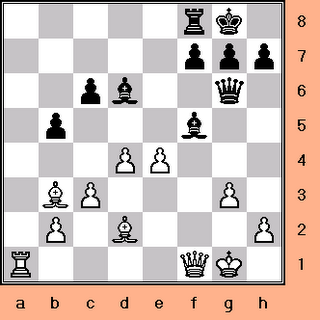
25 ... Bxe4
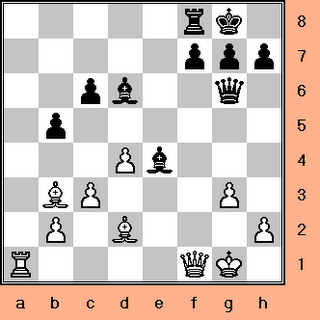
26 Bf4
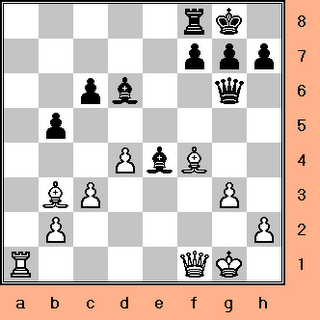
26 ... Bd3
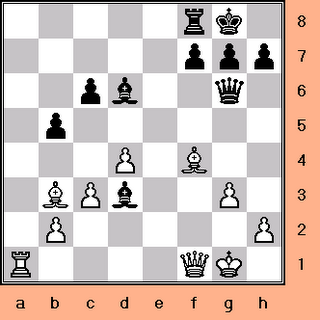
26 ... Bxf4
27 Qf2
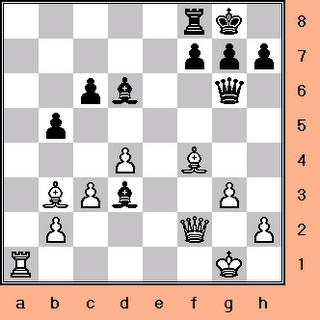
27 ... Bxf4
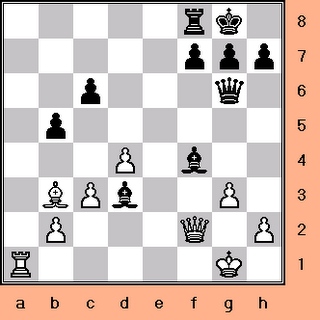
28 Qxf4
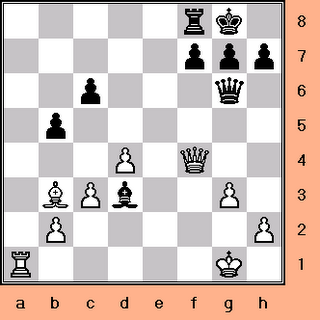
28 ... h6

By ChessCoach@care2.com
6 Re1 b5 7 Bb3 O-O 8 c3 d5 9 exd5 Nxd5 10 Nxe5 Nxe5
11 Rxe5 c6 12 d4 Bd6 13 Re1 Qh4 14 g3 Qh3 15 Be3 Bg4
16 Qd3 Rae8 17 Nd2 Re6 18 a4 Qh5 19 axb5 axb5 20 Ne4
20 ... Bf5 21 Bd2 Rxe4 22 Rxe4 Nf6 23 f3 Qg6 24 Qf1 Nxe4
25 fxe4 Bxe4 26 Bf4 Bd3 27 Qf2 Bxf4 28 Qxf4 h6 Line

What's the game plan for Black?
* Sacrifice the e5 pawn in return for:
(i) an attack along the dark squares
(12 ... Bd6, 13 ... Qh4).
(ii) an attack along the light squares
(14 ... Qh3, 15 ... Bg4).
(iii) an open e-file (16 ... Rae8).
What's the game plan for White?
* Accept the proffered pawn (10 Nxe5).
* Prevent Black's dark- and light-squared
threats by 14 g3 and 16 Qd3 respectively.
* Promptly mobilize the queenside
(15 Be3, 17 Nd2).
* Liberate the a1 rook by opening up the
a-file (18 a4, 19 axb5).
1 e4

Opening up a diagonal for the Queen and f1 bishop, and,
attacking the d5 and f5 squares.
1 ... e5

Black copies White with the same idea in mind.
2 Nf3

Not merely bringing the knight nearer the
center of operations but also assailing Black's
e5 pawn. If possible, always develop with attack
so as to speed up mobilization and harass the
enemy.
2 ... Nc6

The knight comes out to protect the threatened pawn.
3 Bb5

White indirectly attacks Black's e5 pawn by threatening
to remove its defender (Bxc6). Moreover, he prepares for
a rapid kingside castling and dissuades the advancement
of the d7 pawn because of the prospective pin on the
knight.
3 ... a6

So that, when the bishop retreats to a4, he can hold in
reserve the possibility of driving it back altogether by
... b5.
3 ... Nf6
3 ... f5
3 ... g6
3 ... Bc5
3 ... Nd4
3 ... Nge7
3 ... d6
3 ... Bb4
3 ... Be7
3 ... a5
3 ... Qe7
3 ... Qf6
3 ... Nb8
3 ... Na5
3 ... Bd6
3 ... f6
3 ... Nce7
3 ... a6 (Closed Ruy Lopez)
3 ... a6 (Flohr-Zaitsev Variation)
3 ... a6 (Open Ruy Lopez Part I)
3 ... a6 (Open Ruy Lopez Part II)
3 ... d5? 4 Nxe5 Qg5 5 Nf3 Qe7 6 e5.
3 ... g5? 4 d4 Nxd4 5 Nxd4 exd4 6 Qxd4 Qf6
7 e5 Qe7 8 O-O c6.
4 Ba4

4 Bxc6
4 Bc4
4 Be2
4 Bd3
White cannot as yet win the e5 pawn by 4 Bxc6 dxc6
5 Nxe5 because of 5 ... Qd4, doubly attacking White's
e5 knight and e4 pawn. Consequently, White retires his
bishop to a4, and waits for a more propitious moment to
effect the exchange.
4 ... Nf6

Developing the knight and counter-attacking White's
e4 pawn.
4 ... d6
4 ... b5
4 ... f5
4 ... Nge7
4 ... g6
4 ... Be7
4 ... Bc5
4 ... Qf6
4 ... Nd4
4 ... g5
4 ... f6
4 ... Bb4
5 0-0

White, however, can also ignore this attack.
5 Qe2
5 d4
5 d3
5 Nc3
5 Bxc6
5 c3
5 ... Be7

5 ... Nxe4
5 ... b5
5 ... Bc5
5 ... d6
5 ... Bd6
6 Re1

White now threatens to play 7 Bxc6 dxc6 8 Nxe5,
when 8 ... Qd4 will no longer work because of
9 Nf3.
6 Bxc6
6 Qe2
6 d3
6 d4
6 Nc3
6 c3
6 c4
6 ... b5

Eliminating the aforementioned threat.
6 ... d6
6 ... O-O
6 ... Bc5
7 Bb3

Moving out of harm's way.
7 ... O-O

Securing the King and signalling Black's intent
to play the Marshall Gambit
8 c3

(i) Preparing to build up a pawn center by d4.
(ii) Giving the b3 bishop a retreat square on c2,
where it can check out Black's kingside along the
b1-h7 diagonal.
8 a3
8 Nc3
8 c4
8 Bd5
If White wants to avoid the jungle of complications associated with the text, he can adopt the Anti-Marshall approach via 8 a4. For instance:
8 a4 Bb7 9 d3 d6 10 Nc3 Na5 11 Ba2 b4 12 Ne2 c5
13 Ng3 Rb8 14 Nf5 Bc8 15 N3h4 Ne8 16 Nxe7+
16 ... Qxe7 17 Nf5 Qf6 18 Qg4 b3.
8 a4 b4 9 d3 d6 10 a5 Be6 11 Nbd2 Rb8 12 Nc4 Bg4
13 Be3 Nd7 14 h3 Bxf3 15 Qxf3 Bg5 16 Ba4
16 ... Bxe3 17 Qxe3 Nd4 18 c3 bxc3.
8 ... Rb8 9 axb5 axb5 10 d4 d6 11 d5 Nb4 12 Qe2 Na6
13 Nbd2 Qd7 14 c4 Nc5.
8 a4 d5 9 axb5 dxe4 10 bxc6 exf3 11 Qxf3 e4 12 Qe2 Qd6
13 Nc3 Bf5 14 Ra5 Bg6 15 Nd5 Bd8.
8 d4 is another option for steering the game away from gambit play:
8 d4 d6 9 c3 Bg4 10 d5 Na5 11 Bc2 c6 12 h3 Bc8
13 dxc6 Qc7 14 Nbd2 Qxc6 15 Nf1 Nc4 16 Ng3
16 ... Re8 17 a4 Bb7 18 Bd3 Bf8 19 Qe2 d5
20 axb5 axb5 21 Rxa8 Bxa8 22 exd5 Nxd5
23 Nf5 e4 24 N3d4.
8 d4 Nxd4 9 Nxd4 exd4 10 e5 Ne8 11 Qxd4 c5 12 Qe4 Rb8
13 c4 Bb714 Qf5 d6 15 Nc3 dxe5 16 cxb5 axb5
17 Bc2 g6 18 Qxe5.
8 d4 Nxd4 9 Nxd4 exd4 10 e5 Ne8 11 Qxd4 Bb7 12 c4 bxc4
13 Qxc4 d5 14 exd6 Nxd6 15 Qg4 Bf6 16 Nc3 Rb8
17 Bf4 Bc6 18 Rad1 Rb4.
8 d4 Nxd4 9 Nxd4 exd4 10 e5 Ne8 11 Qxd4 Bb7 12 Bd5 c5
13 Qe4 Bxd5 14 Qxd5 Nc7 15 Qf3 d5.
8 d4 exd4 9 e5 Ne8 10 Bd5 Bb7 11 Nxd4 Rb8 12 Nf5 Kh8
13 Nc3 f6 14 e6 dxe6 15 Rxe6.
8 d4 exd4 9 e5 Ne8 10 Bd5 Rb8 11 Be4 f6 12 Qd3 fxe5
13 Bxh7+ Kh8 14 Nxe5 Nxe5 15 Rxe5 d6 16 Re2 c5
17 Bg6 Bh4.
8 d4 exd4 9 e5 Ne8 10 Nxd4 Nxd4 11 Qxd4 c5 12 Qe4 Nc7
13 c4 bxc4 14 Bc2 g6 15 Bh6 Re8 16 Nc3 (16 Qxc4) 16 ... Rb8
17 Qxc4 Rb4 18 Qd3 Rh4.
8 d4 exd4 9 e5 Ne8 10 Nxd4 Nxd4 11 Qxd4 c5 12 Qe4 Rb8
13 c4 Bb7 14 Qe2 b4 15 Nd2 Nc7 16 Ne4 Ne6 17 Qd3.
8 d4 exd4 9 e5 Ne8 10 Nxd4 Nxd4 11 Qxd4 Bb7 12 c4 bxc4
13 Qxc4 d5 14 exd6 Nxd6 15 Qg4 Bf6 16 Nc3.
8 d4 exd4 9 e5 Ne8 10 Nxd4 Nxd4 11 Qxd4 Bb7 12 Qg4 c5
13 c3 d5 14 Nd2 Qb6 15 Bc2 Bc8 16 Qe2 g6 17 a4 bxa4
18 Bxa4 Ng7.
8 h3 Bb7 9 d3 d6 10 a3 Na5 11 Ba2 c5 12 Nc3 Nc6
13 Nd5 Nxd5 14 Bxd5 Qc7 15 c3 Nb8 16 Bxb7 Qxb7 17 d4 Nd7.
8 d3 d6 9 c3 Na5 10 Bc2 c5 11 Nbd2 Re8 12 Nf1 Nc6
13 h3 h6 14 Ng3 Bf8 15 d4 cxd4 16 cxd4 exd4 17 Nxd4 Nxd4
18 Qxd4 Be6 19 Bf4 Rc8 20 Bb3 d5.
8 ... d5

Initiating the Marshall Gambit. Black threatens
to capture on e4 (... dxe4) in order to attack the
f3 knight and stifle White's game in the center.
8 ... d6
8 ... Bb7
8 ... Re8
9 exd5

Preventing 9 ... dxe4 and threatening to capture the
knight.
9 d4 exd4.
9 d4 Nxe4.
9 d4 dxe4.
9 d3 dxe4 10 dxe4 Qxd1 11 Bxd1 Bb7/ 11 ... Rd8/ 11 ... Bg4.
9 a4 dxe4 10 axb5 exf3 11 bxc6 fxg2 12 d4.
9 a4 Bb7 10 axb5 axb5 11 Rxa8 Bxa8 12 d4 Nxe4 13 dxe5 Bc5
14 Re2 Ne7.
9 ... Nxd5

Gaining his pawn back.
9 ... e4 10 dxc6 exf3 11 d4 fxg2 12 Bg5/12 Qf3.
9 ... e4 10 dxc6 exf3 11 d4 Re8/ 11 ... Bg4/ 11 ... Bd6.
9 ... e4 10 dxc6 exf3 11 Qxf3 Bg4 12 Qg3 Re8 13 Re3/ 13 f3/
13 Re5.
10 Nxe5

10 a4
10 d3
10 h3
10 d4 exd4 11 cxd4 Bg4 12 Nc3 Nb6.
10 ... Nxe5

11 Rxe5

White wins the e5 pawn and attacks the d5 knight a
second time.
11 ... c6

Since the knight is attacked twice and protected only
once, Black shields it a second time.
11 ... Bd6 12 Re1 c6 13 d4/ 13 d3/ 13 g3/ 13 a4.
11 ... Bd6 12 Rxd5 Re8 13 g3 Bb7 14 d4 Qd7.
11 ... Bb7 12 d4 Bf6 13 Re1 Re8 14 Na3 b4 15 Nc4 bxc3 16 Na5.
11 ... Nf6 12 d4 Bd6 13 Re1 Ng4 14 h3 Qh4 15 Qf3 Nxf2 16 Bd2.
11 ... Nb6 12 d4 Bd6 13 Bg5 Qd7 14 Re1 Bb7 15 Nd2 Rae8
16 Bh4 Rxe1+ 17 Qxe1 Re8 18 Qd1.
11 ... Nf4 12 d4 Ng6 13 Re1 Bb7 14 Nd2 c5 15 Nf3 c4 16 Bc2 f5
17 Ne5 Qd5 18 f3 Nxe5 19 dxe5 Qe6.
12 d4

(i) Supports e5.
(ii) Contends for c5.
(iii) Enables queenside development.
The c1 bishop is about to jump into the game along
the c1-h6 diagonal, and, thereafter, the b1 knight
can join the action by maneuvering towards the center
(Nb1-d2-e4/f3).
However, White has to put all those ambitions on hold,
because from now on he's forced to play to Black's tune.
That's the price of winning the e5 pawn (10 Nxe5/ 11 Rxe5)!
12 d3
12 Bxd5
12 Re1
12 g3
12 Qf1
12 h3
12 Bc2
12 ... Bd6

And the onslaught begins with an attack on White's
forward rook.
13 Re1

Back to square one.
13 Bg5 Qc7.
13 Re2 Qh4 14 g3 Qh5 15 Nd2 Bh3 16 f3.
13 ... Qh4

The queen works in conjunction with the d6 bishop
to pressurize White's h2 pawn (14 ... Qxh2+/ 14 ... Bxh2+).
14 g3

Eliminating the threat of 14 ... Qxh2+/ 14 ... Bxh2+.
14 h3 Bxh3 15 gxh3 Qxh3 16 Re5 Bxe5 17 dxe5 Rfe8.
14 h3 Bxh3 15 gxh3 Qxh3 16 f4 Nxf4 17 Bxf4 Bxf4.
14 h3 Bxh3 15 Bxd5 cxd5 16 gxh3 Qxh3 17 f4 Rae8.
14 h3 Bxh3 15 Bxd5 cxd5 16 gxh3 Qxh3 17 Be3 Bh2+
18 Kh1 Rfe8.
14 ... Qh3

Since 14 g3 foils his dark-squared invasion
(14 ... Qxh2+/ 14 ... Bxh2+), Black turns his attention
to attacking the light squares. The queen and c8 bishop
team up in preparation for an assault on White's kingside.
15 Be3

Urgently developing his queenside.
15 Bxd5
15 Qd3
15 Qf3
15 a4
15 Bc2
15 Re4 g5 16 Qe2 f5 17 Bxd5+ cxd5 18 Re6 f4 19 Rxd6 Bg4
20 Qf1 Qxf1+ 21 Kxf1 Rae8 22 Bd2 Bh3+ 23 Kg1 fxg3 24 hxg3 Re2 25 Be3 Rxe3 26 fxe3 Rf1+ 27 Kh2 g4 28 Rxd5 Rf2+.
15 Re4 g5 16 Qe2 f5 17 Bxd5+ cxd5 18 Re6 f4 19 Rxd6 Bg4
20 Qf1 Qxf1+ 21 Kxf1 Rae8 22 Bd2 Bh3+ 23 Kg1 fxg3 24 hxg3 Re2 25 Be3 Rxe3 26 fxe3 Rf1+ 27 Kh2 g4 28 Nd2 Rxa1 29 Rxa6 Re1.
15 Re4 g5 16 Qe2 f5 17 Bxd5+ cxd5 18 Re6 f4 19 Rxd6 Bg4
20 Qf1 Qxf1+ 21 Kxf1 Rae8 22 Bd2 Bh3+ 23 Kg1 fxg3 24 hxg3 Re2 25 Rh6/ 25 f4.
15 Re4 g5 16 Qe2 f5 17 Bxd5+ cxd5 18 Re6 f4 19 Rxd6 Bg4
20 Qf1 Qxf1+ 21 Kxf1 Rae8 22 Bd2 Bh3+ 23 Re2/ 23 f3.
15 Re4 g5 16 Qe2 f5 17 Bxd5+ cxd5 18 Re6 f4 19 Rxd6 Bg4
20 Qf1 Qxf1+ 21 Kxf1 Rae8 22 Bd2 fxg3 23 hxg3 Bh3+.
15 Re4 g5 16 Qe2 f5 17 Bxd5+ cxd5 18 Re6 f4 19 Rxd6 Bg4
20 Qf1 Qxf1+ 21 Kxf1 Rae8 22 Bd2 Re2.
15 Re4 g5 16 Qe2 f5 17 Bxd5+ cxd5 18 Re6 f4 19 Rxd6 Bg4
20 Qf1 Qxf1+ 21 Kxf1 Rae8 22 Rh6 Rf6.
15 Re4 g5 16 Qe2 f5 17 Bxd5+ cxd5 18 Re6 f4 19 Rxd6 Bg4
20 Rh6/ 20 Qe5/ 20 Qd3/ 20 f3.
15 Re4 g5 16 Qe2 f5 17 Bxd5+ cxd5 18 Re6 Bxe6?.
15 Re4 g5 16 Qe2 f5 17 Re6/ 17 Re8.
15 Re4 g5 16 Qe2 Nf6/ 16 ... Bf5.
15 Re4 g5 16 Qf3 Bf5 17 Bxd5 cxd5 18 Re3 Rad8 19 Nd2 Rfe8
20 a4/ 20 b3/ 20 a3.
15 Re4 g5 16 Qf3 Bf5 17 Bxd5 cxd5 18 Re3 Be4 19 Rxe4 dxe4
20 Qf6 Qg4 21 Nd2 Rae8 22 Nf1 Be7 23 Qxa6 f5 24 Qxb5.
15 Re4 g5 16 Qf3 Bf5 17 Bxd5 cxd5 18 Re3 Be4 19 Rxe4 dxe4
20 Qf6 Qg4 21 Qxg5+ Qxg5 22 Bxg5 f5.
15 Re4 g5 16 Qf3 Bf5 17 Bc2 Bxe4 18 Bxe4 Qe6 19 Bxg5 f5
20 Bd3/ 20 Bxd5.
15 Re4 g5 16 Qf3 Bf5 17 Bc2 Bf4/ 17 ... Rae8/ 17 ... Nf4.
15 Re4 g5 16 Qf3 Bf5 17 Nd2/ 17 Re1.
15 Re4 g5 16 Qf1/ 16 Bxg5/ 16 Nd2.
15 Re4 Qd7/ 15 Bb7/ 15 Bd7/ 15 Nf6.
15 ... Bg4

Not only attacking the queen but also setting up for
... Bf3 and ... Qg2 mate.
15 ... Re8
15 ... Be6
15 ... Bf5
15 ... Ra7
16 Qd3

Evading capture and enabling Qd3-f1. Should Black
threaten ... Bf3 and ... Qg2 mate, White can cover
g2 by way of Qd3-f1.
16 f3? Bxg3.
16 ... Rae8

The idea is to pressurize the e-file, particularly e3.
16 ... f5
16 ... Nxe3
16 ... Nf4
16 ... Bf3
16 ... Kh8
16 ... Rfe8
17 Nd2

Mobilization towards e4/f3.
17 Bd1.
17 Bxd5 cxd5 18 Qf1 Qh5 19 Nd2 f5 20 f4.
17 ... Re6

(i) Facilitates the doubling of rooks on the e-file.
(ii) Positions the rook for a potential kingside relocation
(Re6-h6).
17 ... f5
17 ... Qh5
17 ... Kh8
18 a4

18 c4
18 Qf1
18 Bd1
18 Bxd5
18 ... Qh5

18 ... f5
18 ... bxa4
18 ... b4
18 ... Rfe8
18 ... Bxg3
18 ... Nxe3
18 ... Bf4
19 axb5

19 Qf1
19 Nf1
19 Bd1
19 ... axb5

20 Ne4

20 Nf1
20 Qf1
20 c4
20 Bd1
20 Bxd5
20 ... Bf5

20 ... Bc7
21 Bd2

21 Bd1
21 ... Rxe4

21 ... Rfe8
22 Rxe4

22 ... Nf6

22 ... Qg6
23 f3

23 ... Qg6

24 Qf1

24 Bc2
24 Qe2
24 Qe3
24 Rae1
24 ... Nxe4

25 fxe4

25 ... Bxe4

26 Bf4

26 ... Bd3

26 ... Bxf4
27 Qf2

27 ... Bxf4

28 Qxf4

28 ... h6

By ChessCoach@care2.com

0 Comments:
Post a Comment
<< Home